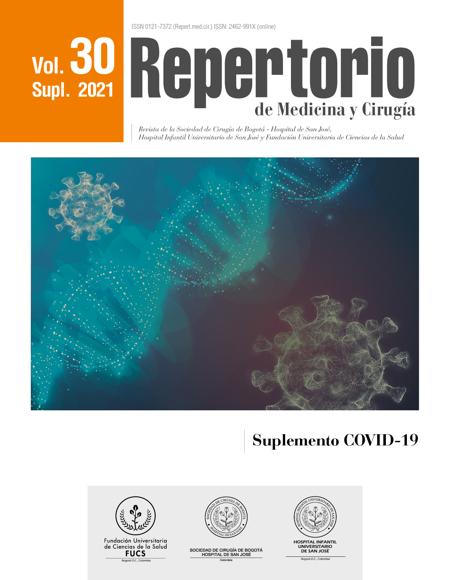Desarrollo de una máscara de bajo costo para prevenir la propagación de aerosoles en endoscopia endonasal en la base del cráneo durante la pandemia del COVID-19
Desarrollo de una máscara de bajo costo para prevenir la propagación de aerosoles en endoscopia endonasal en la base del cráneo durante la pandemia del COVID-19
How to Cite
Download Citation
![]()
![]()

Show authors biography
Objective: to develop a reusable, sterilizable, easy- to-use and low-price mask to reduce the risks of COVID-19 transmission during endonasal endoscopic procedures. Methods: a model designed using Autodesk Fusion 360 and Meshier software, made from polylactic acid (PLA) in a 3D printer (PRUSA IK3 MK3s, Prague, Czech Republic) at the anatomy laboratory of Universidad de los Andes, Bogotá, Colombia. It features three ports, one to allow passage of intubation tubing, a larger middle port for surgical tool insertion, which allows fitting a sterile translucent membrane, and an upper port for the suction tube tip to create a negative pressure environment inside the mask. A silicone cushion and three ties secure the mask to the head for long periods of time without skin injuries. Various tests were completed, ultraviolet light verification of fluorescein propagation after bone drilling, chemical and vapor sterilization, and aerosols filtration using smoke produced by an electronic cigarette. Setting: an experimental laboratory. Results: Tests showed the mask decreased aerosol effect and droplet dispersion, and allowed for excellent maneuverability and freedom. However, the mask was limited in terms of visualization during nasal approaches to the skull. Conclusions: preliminary results show that this ventilated mask allows for a surgical barrier for reducing SARS-COV-2 transmission during endonasal endoscopic procedures.
Article visits 647 | PDF visits 305
Downloads
- Majra D, Benson J, Pitts J, Stebbing J. SARS-CoV-2 (COVID-19) superspreader events. J Infect. 2020; 82(1):36-40. doi: 10.1016/j.jinf.2020.11.021.
- Workman AD, Welling DB, Carter BS, et al. Endonasal instrumentation and aerosolization risk in the era of COVID-19: simulation, literature review, and proposed mitigation strategies. Int Forum Allergy Rhinol. 2020;10(7):798-805. doi: 10.1002/alr.22577.
- Workman AD, Jafari A, Welling DB, et al. Airborne Aerosol Generation During Endonasal Procedures in the Era of COVID-19: Risks and Recommendations. Otolaryngol Head Neck Surg. 2020;163(3):465-470. doi: 10.1177/0194599820931805.
- Zhu W, Huang X, Zhao H, Jiang X. A COVID-19 Patient Who Underwent Endonasal Endoscopic Pituitary Adenoma Resection: A Case Report. Neurosurgery. 2020;87(2):E140-E146. doi: 10.1093/neuros/nyaa147.
- Helman SN, Soriano RM, Tomov ML, et al. Ventilated Upper Airway Endoscopic Endonasal Procedure Mask: Surgical Safety in the COVID-19 Era. Oper Neurosurg (Hagerstown). 2020;19(3):271-280. doi: 10.1093/ons/opaa168.
- Bellmunt JM, Cayla JA, Millet JP. [Contact tracing in patients infected with SARS-CoV-2. The fundamental role of Primary Health Care and Public Health]. Semergen. 2020;46 Suppl 1:55-64. doi: 10.1016/j.semerg.2020.06.001.
- Champagne PO, McDowell MM, Wang EW, Snyderman CH, Zenonos GA, Gardner PA. Early practices in endonasal skull base surgery during the COVID-19 pandemic: a global survey. Neurosurg Focus. 2020;49(6):E12. doi: 10.3171/2020.9.FOCUS20569.
- Touhara K, Hawes BE, van Biesen T, Lefkowitz RJ. G protein beta gamma subunits stimulate phosphorylation of Shc adapter protein. Proc Natl Acad Sci U S A. 1995;92(20):9284-9287. doi: 10.1073/pnas.92.20.9284.
- Tuli IP, Trehan S, Khandelwal K, et al. Diagnostic and therapeutic endonasal rhinologic procedures generating aerosol during COVID-19 pandemic: a systematized review. Braz J Otorhinolaryngol. 2021; 87(4):469-477. doi: 10.1016/j.bjorl.2020.11.008.
- Lo YT, Yang Teo NW, Ang BT. Editorial. Endonasal neurosurgery during the COVID-19 pandemic: the Singapore perspective. J Neurosurg. 2020:1-3. doi: 10.3171/2020.4.JNS201036.
- Solari D, Bove I, Esposito F, Cappabianca P, Cavallo LM. The nose lid for the endoscopic endonasal procedures during COVID-19 era: technical note. Acta Neurochir (Wien). 2020;162(10):2335-2339. doi: 10.1007/s00701-020-04518-z.
- Viera-Artiles J, Mato D, Valdiande JJ, et al. A novel aerosolisation mitigation device for endoscopic sinus and skull base surgery in the COVID-19 era. Eur Arch Otorhinolaryngol. 2021;278(6):1869-1877. doi: 10.1007/s00405-020-06462-1.
- Liaw CY, Guvendiren M. Current and emerging applications of 3D printing in medicine. Biofabrication. 2017;9(2):024102. doi: 10.1088/1758-5090/aa7279.












